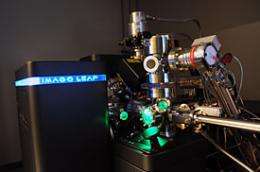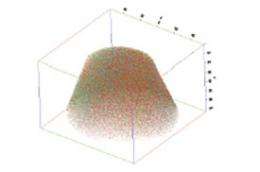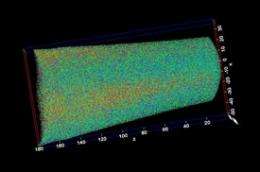Understanding of radiation damage LEAPs forward

A faint nightclub beat greets visitors to a small room housing the Localized Electron Atom Probe (LEAP). But that’s no stereo cranking out house music; it’s a rhythmic pump cooling a tiny sample to more than 220 degrees C below zero (that’s -425 degrees F).
Deep within, the device is taking apart, atom by atom, a bit of ceramic smaller than the tip of a pin. A computer will collect data about each atom, which researchers will feed into software that can help reconstruct the sample. The information can reveal, in minute detail, how the material responds to irradiation.
This work can help researchers understand factors that may cause weaknesses in materials exposed to prolonged radiation inside a nuclear reactor. Such understanding drives development of new materials with significantly improved performance, a core aspect of Idaho National Laboratory’s nuclear research mission.
That's why INL is leading efforts to adapt advanced techniques such as LEAP for use on irradiated materials. In fact, the Center for Advanced Energy Studies at INL is home to the LEAP that has generated some of the clearest results ever obtained for samples that mimic irradiated fuel.
A new research paper co-authored by INL scientist Melissa Teague describes that work. Her colleague Jim Cole is overseeing projects seeking similar information for steels and steel alloys used inside current and future nuclear reactors. Both research efforts can provide a more fundamental understanding of how radiation damages materials inside nuclear reactors.
"We want to understand how radiation affects the structure of materials, how that in turn affects its properties, and relate those changes to how a material performs," said Cole, who is chief scientist for the Advanced Test Reactor (ATR) National Scientific User Facility at INL. "This gives us information so we may be able to process materials in a way to get better performance."
An up-close look at radiation damage
Nuclear energy has safely provided the largest portion of carbon-free electricity in the U.S. for more than half a century. Yet nuclear engineers are always researching ways to make the energy source ever safer and more efficient. A key component involves understanding how radiation affects materials.
Such research hinges on microscopic analysis of materials that have been irradiated inside a nuclear reactor. Studying weaknesses on a microscopic level can provide molecular insight into what makes materials weak or prone to cracking. This insight can enable advances to make materials more radiation-resistant.
But irradiated materials can be brittle and highly radioactive. The special challenges associated with handling them make it difficult for researchers to utilize advanced examination tools that have become routine for other scientists. INL has been pioneering methods to put such techniques within reach for irradiated materials research.
An INL research collaboration has recently demonstrated the ability to analyze an irradiated fuel-like sample using the advanced LEAP instrument at CAES, a collaboration between INL and Idaho's three public research universities. The work has been submitted for publication in the Journal of the American Ceramic Society.
Hallmarks of stability in nuclear fuel

New types of nuclear fuel could boost efficiency by wringing more energy from each fuel rod. For example, mixed oxide (MOX) fuel containing both uranium and plutonium has been used in fast breeder reactors, but the long-term performance of MOX fuels is not yet well understood.
To determine how irradiation may weaken nuclear fuel elements, researchers need to understand how the fission process can cause changes on the molecular level. For example, when an ejected neutron bombards an atom and splits it in two, researchers want to know if the fission products congregate together or stay put.

"Do they segregate or are they more stable and immobile?" Teague and her collaborators at the Colorado School of Mines want to know. "If they're mobile, that can compromise stability or damage the protective fuel cladding."
Such information is hard to come by, but Teague and her colleagues have demonstrated how to get it. The team irradiated cerium-oxide — a close relative that can serve as a surrogate for MOX fuel — and analyzed it using the LEAP. This provided high-resolution atom probe tomography data that revealed the specific location of key fission products.
The study illustrates how nuclear fuel designers can obtain the type of information that informs the development of any new material. For example, to ensure a car’s tires remain safe, it’s important to understand conditions that cause them to fail. A better understanding of those conditions can enable design of safe tires that last longer.
This same principle underlies many areas of nuclear materials research.
Detecting defects in reactor steels
Nuclear fuels aren't the only materials in a reactor that are damaged by radiation. The steels and other alloys comprising reactor pressure vessels and other components may also suffer under prolonged exposure.
LEAP analysis can reveal changes that lead to embrittlement: helium bubbles, solid precipitates or other defect clusters. Such features can be especially damaging at the "grain boundaries" of a solid material — the place where one crystal lattice ends and another begins.
"Radiation can cause chemical changes at the grain boundary and make the materials more susceptible to cracking," says Cole.
Several research teams are using the LEAP at CAES to study these phenomena. Some are testing new alloys, while others are examining existing reactor steels to learn more about their performance under varied conditions. These data can inform decisions about the safety of extending operating licenses for existing reactors.
"Radiation damage can be on a scale of sub-nanometers," Cole says. "The LEAP analysis complements transmission electron microscope data and can detect defect clusters a few atoms in diameter."
Oak Ridge National Laboratory and the University of California, Santa Barbara (UCSB) — both INL collaborators — pioneered such work. The LEAP extends these capabilities for irradiated fuels and makes them more accessible to outside collaborators through CAES and the ATR National Scientific User Facility.
The future of nuclear materials research
One User Facility project, a collaboration with UCSB, is assembling a large sample library of both conventional and advanced materials irradiated inside INL’s Advanced Test Reactor. Researchers both inside and outside INL will be able to examine the library to see if they want to study any of these materials using the advanced tools, such as the LEAP, being made available at INL or other partner facilities.
And work continues to bring the LEAP online for irradiated fuels testing. Teague and her team have now prepared unirradiated samples of genuine MOX fuel for testing this spring. By summer, they expect to be examining irradiated MOX fuel samples with the LEAP.
This graded approach to introducing irradiated fuels helps ensure no unexpected behavior from either the materials or the machine. But once complete, the ability to examine irradiated nuclear fuel so closely will be a unique capability that promises to advance nuclear research and offer new insights.
"This model can distinguish elements with very close isotopes," said Yaqiao Wu, a research associate professor with Boise State University, which runs the CAES Microscopy and Characterization Suite where the LEAP resides. "It's a big advantage over other 3D atom probe machines."
Provided by Idaho National Laboratory


















